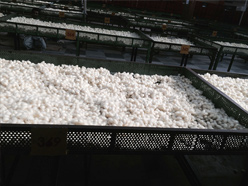Nrupathunga S K
Silk production has lost its sheen in the state owing to unstable market. Nrupathunga S K analyses the situation and compares it with Switzerland’s renewed interest in this occupation.
Silk production has lost its sheen in the state owing to unstable market. Nrupathunga S K analyses the situation and compares it with Switzerland’s renewed interest in this occupation.
India stands second in silk production, after China, in the world and Karnataka is the largest producer in the country. However, it is disheartening to note that the fluctuating market prices have caused trouble to the state’s silk farmers, leaving them in distress.
K Jagadeeshwar, Director of Extention, University of Agricultural Sciences, Bengaluru views that the government’s current policies, including import, as the major reason for the present situation. Further, the area under mulberry cultivation is shrinking in many districts, including Chikkaballapura due to the depletion of ground water level and the absence of remunerative price in the market.
“Silk production has not decreased in Karnataka. In fact the production of mulberry silk has increased from 8.574 metric tonnes last year to 9,645 metric tonnes this year,” says K K Shetty, Joint Director of Central Silk Board. “It is not possible to implement price support scheme for silk farmers as silk cocoon, unlike other crops, can’t be stored for long in warehouses,” he adds.
Tumakuru, Kolara, Ramanagara, Chikkaballapura, Mandya, Chamarajanagara, Mysuru and Bengaluru Rural are the major mulberry cultivating districts of the state. Lakshman, a silk cocoon producer from Ramanagara, feels the farmers may have to shift to other crops if they don’t get timely support from the government. Farmers feel that the price has to be fixed at a minimum of Rs 300 per kg of silk cocoons in the market as the cost of the production crosses Rs 200 per kg. But, silk reelers prefer China raw silk to local silk as they find the former cheap. Co-operative ventures by farmers to set up silk reeling units might help the producers to cope with the situation.
The Swiss link
Far from Ramanagara, in Switzerland, a group of farmers is trying to rejuvenate silk. One of them is Ueli Ramseier, a government employee-cum-silk farmer, who has initiated silk production in the country and left no stone unturned to restore silk in Swiss farms.
Ueli reveals that around 750 years ago, the migrants from Italy produced silk in Zurich, the Swiss commercial capital. However, the production declined during crises like the reformation process and the 30-year European war. The migrants resumed to silk production after the war. Though silk production was never steady it had made an impact on the country’s economy. The capital gained from silk production and processing led to the birth of banks.
Having realised the importance of this natural fabric and its past existence, Ueli made up his mind to produce silk 14 years ago. Then he came to know about a project on reproduction of silk in Southern France in 1980s. This prompted him to explore various methods of producing silk. It was then he came across Aryan engineering works limited, a Bengaluru-based company. He consulted the company and soon purchased a silk reeling machine. He also undertook training at Shidlaghatta in Chikkaballapura district to learn silk reeling. And now, Ueli claims to own the lone silk reeling machine in Europe. Later, he planted mulberry saplings, in his land at Hinterkappelen near Bern.
He has also formed an association comprising of farmers, consumers and traders with the sole intention of promoting silk in Switzerland and restoring its past glory. The group believes that promoting ‘Swiss Silk’ is the best way to tackle globalisation. They are also instilling the concept of ‘Swissness’ in the minds of people to promote locally produced silk. He sells raw silk to branded companies like Weisbrod and Soeder.
Struggle against nature
Although the situation seems encouraging, all is not so sheen. Ueli feels that Swiss silk is not the competitor at the global-level as the country’s climate restricts silk production to five months (from June to October) a year. Silk farmers in Switzerland don’t even get government aid. He says,“It has always been a struggle against nature. However, there is hope and I could sell 250 shawls and ties in 2014. The sales would definitely improve this year. My goal is to reach 5 per cent of the market from the current one per cent. I want to launch a sustainable, quality product.”
I don’t expect any subsidy from the government for this,” he says. Ueli had produced 13 kg of silk last year in association with other growers. The group is active with 10 of them producing worms and 30 getting involved in the entire process. Silk farming requires three days work evey week, while it constitutes 20 per cent of his income. He imports silk worm eggs from Italy and admits that the quality of Swiss silk has to be improved in a big way.
The industry is trying to promote home-grown silk by instilling the concept of Swissness. According to Oilver Weisbrod, CEO of Weisbrod, Swiss silk has received mixed response from people. Some are not happy with the quality and the price of the product, while others are keen to purchase it just because it is ‘Swiss made’.
(The author recently visited Switzerland as part of a journalists exchange programme to understand the impact of globalisation on small farmers. The programme was sponsored by EQDA and the Swiss agency for Development and Co-operation.)







